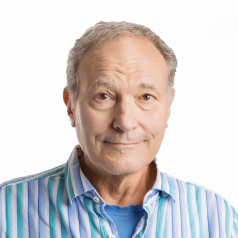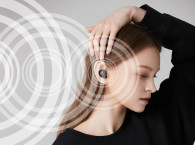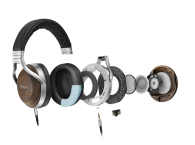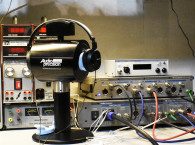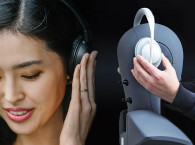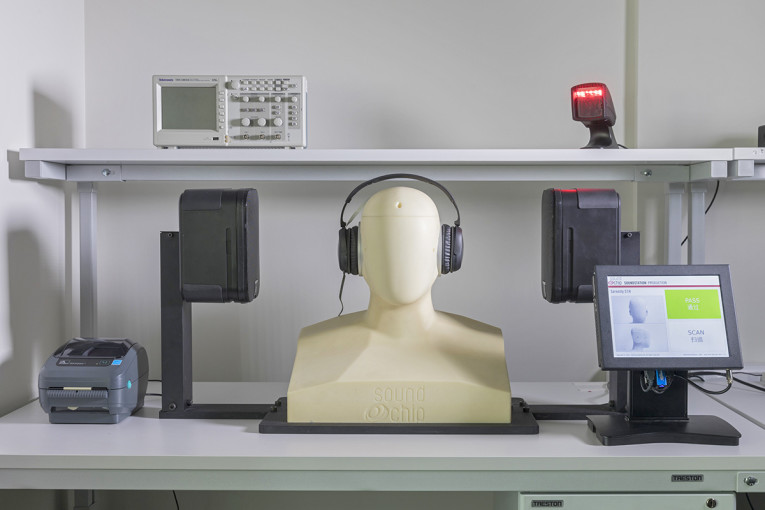
Solutions are available for conventional analog, USBC, and Bluetooth wireless noise cancelling applications, while the company’s silicon is exceptionally well geared toward low power. Working closely with manufacturers throughout their products’ lifecycles — from the conception phase through development and mass production, and then through the long-term, too—offering production data analytics and production line support.
Most headphone engineers, when choosing a noise cancelling solution, focus on whose active noise cancellation (ANC) silicon they will use. From this limited perspective, some of the questions and issues are obvious—filter topology and order, latency, board real estate, battery drain, control, and IO. But some ANC headphone developers also consider the acoustics of their headphones, the development process, end-of-line testing, calibration, and diagnostics as major areas of challenge and uncertainty in meeting their performance targets in serial production.
SoundChip has spent years working to address these challenges through the development of a close support package of reference designs and engineering support, ANC chips from its semiconductor partner STMicroelectronics, and the development of comprehensive design and production tools, including the nearly complete second-generation SoundStation Production—a semi-automated, high-speed test, calibration, programming, and diagnosis platform (see Photos 1–3).
Such a comprehensive package provides partner manufacturers with access to the technology, tools, skills, and experience needed to reliably develop and produce, at scale, high-performance noise cancelling headphones. To leverage this system-level approach to ANC headphone development, the partner manufacturer is required to exercise SoundChip’s Waypoint development platform, which comprises proven methods, tools, and design guidelines.
Furthermore, the manufacturer is required to use integrated circuits (ICs), transducers (particularly microphones), and software that have been qualified as being viable for effective use in ANC applications. Embracing such a comprehensive approach enables partner manufacturers to properly train their engineers in ANC headphone engineering. It also enables manufacturers to establish a production environment, equipped with indispensable technology and tools.

A System-Level Approach
SoundChip might not have a high profile, but the firm is an international leader in system-level audio solutions for ANC. Its proprietary Soundcore-based ICs enable the seamless digital control of analog filters to deliver class-leading hybrid noise cancelling performance and talk-through, as well as several innovative features, including advanced situational awareness.
The less obvious benefits of digitally controlled analog filters are their ability to deliver high levels of noise cancelling without chewing up the sound quality and battery life, as well as the absence of a contentious patent landscape for this approach. In fact, in terms of the latter, SoundChip and its silicon partners’ comprehensive portfolios of digitally controlled analog ANC IPs also provide a safe path through these often treacherous waters.
SoundChip develops its own design tools, which leverage its digitally controlled analog circuit topology, to streamline the tuning of active noise cancelling and audio equalization filters. Soundstation Engineer, the company’s computer-aided-design platform comprises a development board incorporating one of the company’s Soundcore-enabled devices and proprietary software. This tool overcomes the time-consuming and error-prone task of tuning noise cancelling analog filters. With Soundstation Engineer, filter parameters are digitally set and are tuned “point-and-click” using the mouse rather than requiring the manual placement of discrete capacitors and resistors.
Selected tunings are automatically synchronized with the Soundcore-enabled silicon, which is connected to the headphone-in-design. With Soundstation Engineer, the designer may listen to or measure the performance of their tuned filters in real time, which considerably speeds up development.
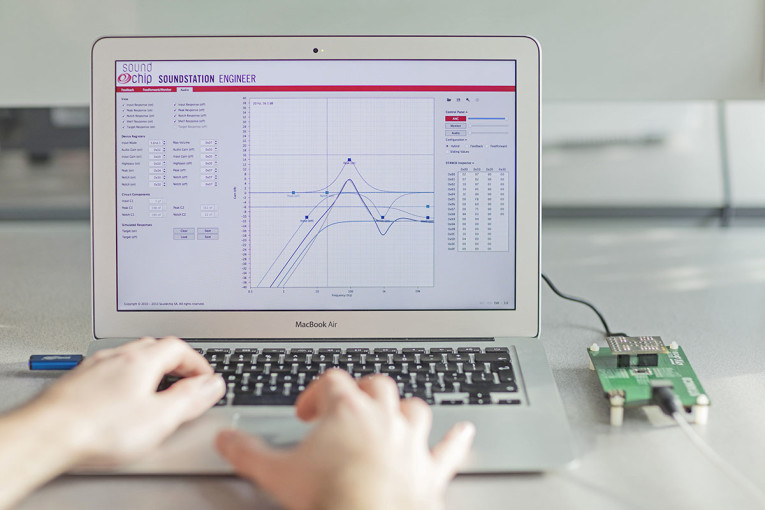
Soundstation Production is a turnkey test, calibration, and programming solution, comprising custom head-and-torso simulator (HATS), custom hardware, custom test software, and cloud-based data analytics tools. The solution accurately captures the electro-acoustic DNA of a headset using high-precision microelectromechanical systems (MEMS)- based ear simulators. User-defined test scripts operate on captured test dataset to screen, calibrate, and program a headset’s noise cancelling and audio compensation filters — whether Soundcore-based or using other supported silicon.
The recently introduced Soundstation Production 2 next-generation test system automates the test through a programming process for smart hybrid noise cancelling headsets in less than 30 seconds with the headset being placed on the test system. It is the only application-specific HATS for end-of-line testing — so instead of floppy ears, there is a product-specific coupling plate to achieve reliable and repeatable measurements matched to a golden sample rather than using lab-based systems. By combining advanced measurement techniques with powerful software algorithms tailored to each product, Soundstation Production 2 is able to identify the root cause of failure for any NG product and report this to the operator. This feature streamlines repair and drives second-pass yield to near 100%, significantly reducing manufacturing costs. SoundStation 2 is typically leased to partner OEM/ODM factories.
To complement Soundstation Production, SoundChip offers access to Soundstation Mission Control — a cloud-based software application that securely stores, analyzes, and generates reports from measurement data captured on the line using the company’s Soundstation Production test equipment.
Mission Control provides remote access to raw measurement data, production metrics and product screening results, to help domain experts identify and analyze batch-rated issues. This extra layer of information helps to maintain production line stability and drive yields higher. Mission Control can also be used to collate bespoke reports for production and acoustic engineers, as well as quality departments and product line managers.
In exercising its unique, top-to-bottom system-level approach, SoundChip has achieved design wins with Philips, Bowers & Wilkins, Harman, and Panasonic, among other large and small audio brands and Tier 1 headset customers.
STMicroelectronics, Europe’s largest semiconductor company, licensed Soundcore electronic IP from SoundChip in 2012 to create a range of highly innovative noise cancelling ICs and MEMS microphones that enable headphones and earphones with class-leading and lowest power feed-forward, feedback and hybrid noise canceling performance. Two devices, STANC0 (see Photo 4) and STANC1, are in active use while the company is showcasing two new devices, STANC2 and STANC3, to key customers. Both STANC1 and STANC3 are single-channel units that operate at very low power, making them ideal choices for power-sensitive wireless applications such as True Wireless Systems (TWS).
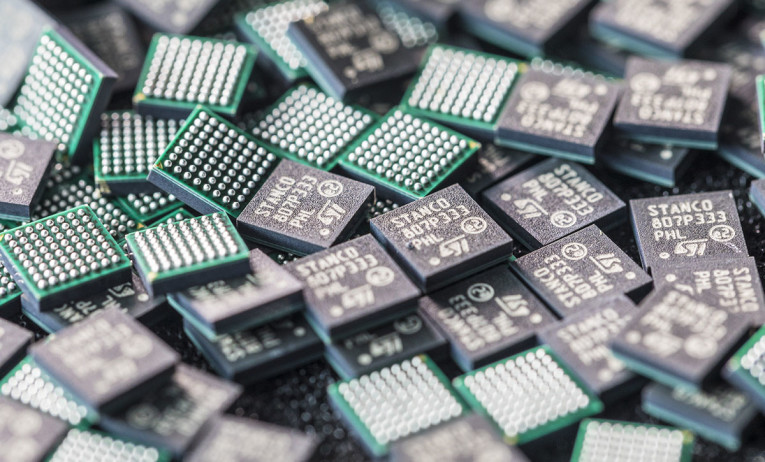
Other IC Supplier Relationships
In January 2018, SoundChip announced that it is offering design-In support for third-party noise cancelling chips providing customers with access to its proven Waypoints development platform and Soundstation computer-aided-engineering and production tools. It is not known which IC vendors beyond STMicroelectronics that SoundChip has partnered with but the company has stated that it recognizes that in a growing marketplace, ICs are optimized for specific target applications and it has chosen to provide its customers with access to a more diverse range of electronics and software solutions where it makes best sense to do so.
The SoundChip Waypoints ANC Program
Waypoints adopts a cradle-to-grave approach that not only streamlines the development of noise cancelling headphones but brings about increased control over their introduction into mass production and continuous manufacturing. Comprising a five-stage process, which responds to the unique challenges of headsets, regulated acoustics, working methods, tools, and design expertise operate in unison to remove technical uncertainty and build confidence in end-product outcomes at the outset of any new program. The platform can be exercised in tandem with customers’ existing processes and covers all facets of end-product design, development, and manufacturing — including end-of-line tests and production monitoring.
Mark Donaldson, CEO of SoundChip, said, “Noise cancellation is a complex technology that demands the careful marrying of electronics, software, and acoustics on a product-specific basis. As our customers have come to understand, successfully deploying an effective noise cancelling capability across multiple product targets requires considerably more than choosing the right silicon. By transforming SoundChip’s unique system-level audio knowledge into powerful working methods and tools, which can be readily exercised by domain experts, we have created a platform capable of scaling the delivery of class-leading noise cancelling into new headsets with unprecedented reliability and speed.”
SoundChip’s OEM/ODM Partnership Program
SoundChip has Soundstation Production test systems installed at numerous OEM/ODM factories in China. The company supports these installations via its Operations Centre, which is located in Central Hong Kong. TongIn (Data Target), TCL, Wata, CMT, and Goertek are established OEM/ODM partners and Tymphany is now entering the ANC headphone market with SoundChip. SoundChip is currently discussing opportunities to partner with prospective manufacturers as well as quality headphone brands and welcomes inquires at www.soundchip.com. VC
The Hidden Challenges of Active Noise Cancellation
By Mike Klasco (Menlo Scientific)
When I visited the SoundChip team, we discussed why some of the most sophisticated brands and OEM/ODMs use their support rather than go it alone. One analogy was that even the most talented doctors will confer with a specialist on tough issues.
Noise cancelling headphone projects involve substantially greater levels of commercial risk than conventional earphones and headphones. From product design, tooling, and target performance trade-offs to materials selection — all are more critical than they are with passive headphones and earphones. Minute details such as glue joints, wall thickness, ribbing, and the consistency of the foam used in the ear cushions become significant factors.
The bottom line is that the best practices that are sufficient for conventional headphones fall short for active noise cancelling headphones. Even design trade-offs such as sound quality vs. noise canceling are non-obvious decisions. All these aspects can result in more challenges than what was originally anticipated in the project development cycle.
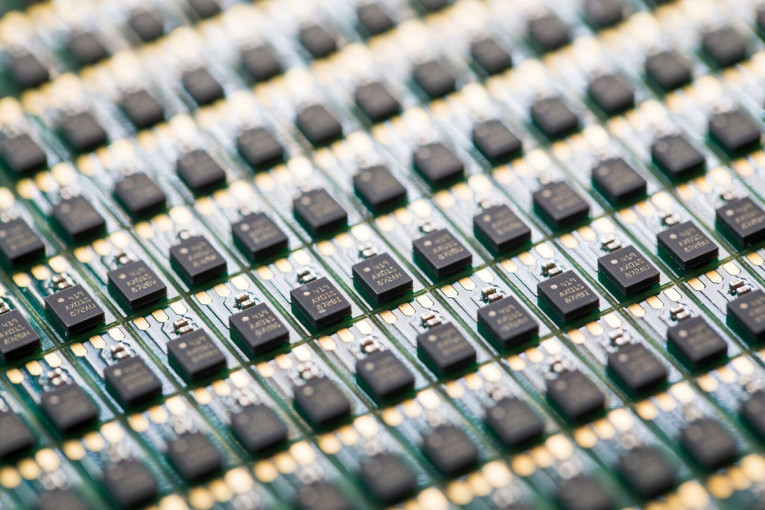
Asian headphone manufacturers such as Foster, Gamma, Long Prosper, Toogin, Merry, and others have struggled to develop and manufacture high-performance noise cancelling headphones for their OEM/ODM customers. At the start of the design and manufacturing journeys, few were fully aware of the complexities associated with active noise cancelling (ANC) headphones.
It is optimistic and ambitious for a headphone engineering team to possess the expertise in system-level audio, headphone electro-acoustics, network control theory, and signal processing needed in order to master this product category — and then hang onto these disparate skills in the form of a cohesive team. To be frank, there are very few talented headphone engineers in Asia.
Every trip to I take to Asia, I see the same faces but at different companies. Many headphone factories’ original core competencies were centered on injection molding, cable fabrication, and buzzer manufacturing. Best practices for passive headphones simply do not include consideration of aspects such as structural leakage between the headphone driver to the feedforward ambient noise pickup microphone, or how eggshell resonances in plastic housings influence active noise cancelling, or the microphonics of microphone wires running through headphone driver chamber. The consistency of the passive attenuation of a headphone’s fit on the ears with different wearers, even the repeatability with the same wearer are all critical factors—especially with feedforward ANC designs.
Manufacturers have experienced these mysterious effects and the related complexities associated with noise cancelling headphones for years and have begun to realize that they need support to excel in this product category. Even the most experienced headphone manufacturers have faced significant challenges when developing their products. Some of the challenges include:
• Correctly specifying a headphone’s acoustical-mechanical configuration such that it is conducive to delivering effective noise canceling
• Optimizing a headphone’s electro-acoustic performance so that it is conducive to delivering effective noise cancelling
• Managing the many complex cause-and-effect relationships resulting from a noise cancelling headphone’s “closed” loop behavior
• Accessing design tools that offer a simple means to tune audio and noise cancelling filters and observe resulting behavior
• Specifying production test requirements and deploying suitable equipment for efficiently performing such tasks, including both test and calibration of production units and identifying the root cause of non-compliant behavior and applying appropriate counter-measures
Since overcoming these challenges often leads to longer product development cycles, higher product development costs, lower production yields, and disappointing performance outcomes, noise cancelling headphone projects involve substantially greater levels of commercial risk than conventional headphones and represent a territory outside of both engineering and management’s comfort zones.
One last caveat relates to the legal liabilities of active noise cancelling as to patents. Noise cancelling headphone projects involve substantially greater levels of risk than conventional headphones not just from design and assembly, but due to intense patent coverage in this field accompanied by aggressive patent protection. As a business decision, the ANC solution selection process should take into account the significant implications of the ANC provider’s patent position and practical experience in noise cancelling IP. SoundChip points to its unique patent position for its topology of digital control of analog processing as the cornerstone of its IP. VC
This article was originally published in Voice Coil, July 2018


